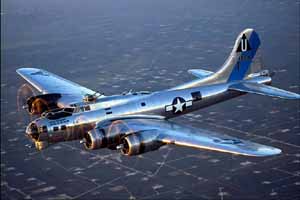Boeing B-17G Fortress (Flying Fortress)
U.S. Heavy Bomber
 |
One of the Ghost Squadron's B-17Gs, Sentimental Journey. Image source: The Confederate Air Force Ghost Squadron CD-ROM produced by Corel. Photos by Bill Crump. |
The Boeing B-17 Fortress, also known in the press and elsewhere as the Flying Fortress, formed the spearhead of the American bombing offensive in Europe, serving from the beginning to the end, with over 12,677 Fortresses being delivered to the USAAF between July 1940 and August 1945.
Although later heavy bombers could carry greater bomb loads, the B-17 earned the universal affection of its crews by its good flight characteristics, excellent high-altitude capability and ability to absorb an amazing amount of battle damage and keep on flying.
The first Fortresses to see combat were B-17C models transferred to Britain under Lend-Lease in the spring of 1941 and known by them as Fortress Is. The U.S. Army Air Corp had 35 B-17C and Ds stationed in the Philippines when the Japanese attacked on 8 December, 1941, plus a flight was attacked on arrival from California at Pearl Harbor.
In April 1942, a new version, the B-17F was introduced on the production lines, incorporating over four hundred design changes and improvements to improve combat efficiency, and this model carried the early brunt of the bombing campaign in Europe.
Despite its nickname of Flying Fortress, the B-17 suffered heavily when flown deep into German-occupied Europe without long-range fighter escort, the range of the fighters in 1942 and early 1943 being too short for such escort. German fighters found that head-on attacks against the groups of Fortresses were particularly effective, as the hand-held machine guns in the nose of the B-17 were not very effective.
The final, definitive version of the B-17 in World War II was the B-17G, as seen here in the CAF hangar. Introduced into production in July 1943, the G-model featured a power-operated "chin" turret mounting two .50 caliber machine guns below the nose. In addition, two "cheek" guns added to the forward firepower of the new Fortress model and proved effective in blunting the head-on attacks.
By the end of the war, B-17s had dropped over 640,000 tons of bombs on European targets and destroyed twenty-three enemy aircraft per thousand sorties, by official records. No other U.S. bomber better represents the concept of American offensive airpower in the Second World War than the Boeing B-17 Fortress.
Specifications
Normal Crew of Ten Four Wright R-1820-97 Engines Eleven to Thirteen .50 caliber Machine Guns Max. Speed 287 mph @ 25,000 feet Climb to 20,000 ft in 37 minutes |
Length 74' 4" Max. Weight 65,500 lbs Normal Fuel 1,700 gallons Max. Range 2,000 miles |